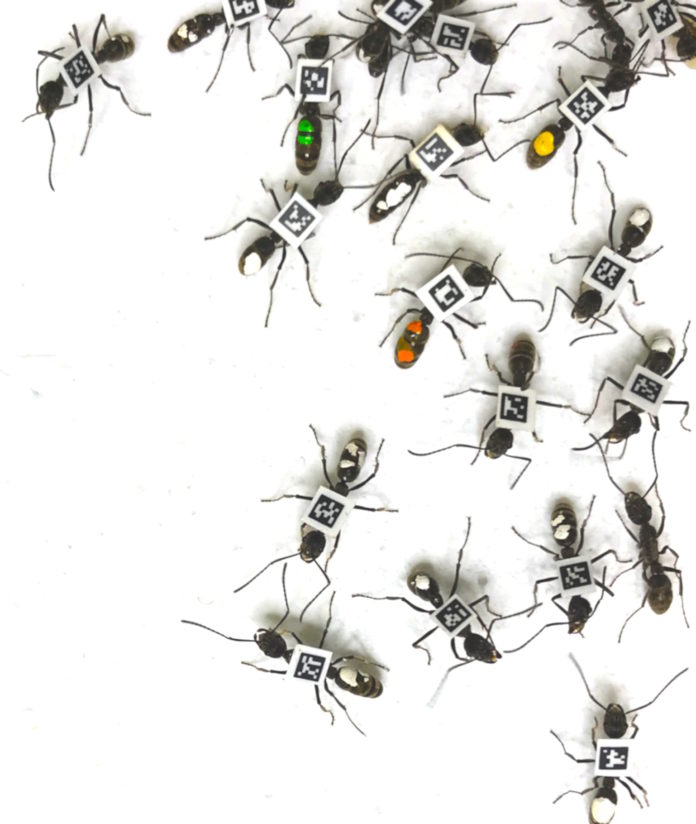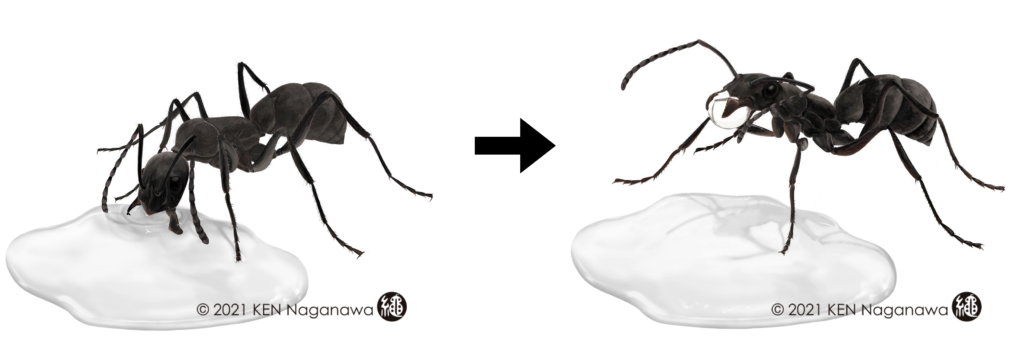How social interactions govern behaviors is a fundamental question in understanding complex biological systems in animal ecology. My main research aim is to understand the chronobiological system of social insects. Circadian rhythms are approximately 24 hours periodicity in various physiological processes and behaviors. I have revealed that adult individuals of circadian rhythms drastically change depending on the social context in ants.
Social interactions change ant’s circadian rhythms
The paper investigated how social interaction among workers and interaction between worker and brood affect adults’ circadian activity rhythms using a Ponerine ant Diacamma cf. indicum. Recent technological advances in image-based tracking systems allow us to collect long-term and highly accurate behavior data. I developed an image-based tracking system to monitor individual-level locomotor activity for several weeks in a small group (~5 ants) and detect social interactions between ants. When grouped with workers from different age groups (i.e., young nurses and old foragers), young and old workers showed weak circadian rhythmicity or around-the-clock activity. These results suggest that even simple social interaction could alter worker activity patterns.
In addition, we found that young workers (i.e., nurses) showed the brood type-dependent activity modification. Therefore, it is considered that the plasticity might be related to the differences in caretaking demands between brood stages.
❖Haruna Fujioka, Masato S. Abe, Yasukazu Okada*, “Ant activity-rest rhythms vary with age and interaction frequencies of workers” Behavioral Ecology and Sociobiology 73.3 (2019): 1-12. doi: 10.1007/s00265-019-2641-8
❖Haruna Fujioka, Masato S. Abe, Taro Fuchikawa, Kazuki Tsuji, Masakazu Shimada, Yasukazu Okada*,
Ant circadian activity rhythms associated brood care type, Biology Letters 13.2 (2017): 20160743. doi:10.1098/rsbl.2016.0743
Circadian rhythms of locomotor activity and task specialization in ant colonies
I evaluated individual activity-rest rhythms under natural colony conditions and investigated how activity-rest rhythms are integrated into colony-level activities. To measure the locomotor activities of all colony members under laboratory colony conditions, I developed an image-based tracking system using 2D barcodes (BugTag) for Diacamma cf. indicum from Japan. Activity-rest rhythms appeared only in isolated ants, not under colony conditions, suggesting that the mixture of worker-brood and worker-worker interactions in the colony induced arrhythmic activity. In addition, I analyzed task allocation patterns from the viewpoint of chronobiology at the colony level. It is difficult to characterize task allocation patterns due to behavioral complexity comprehensively. To reveal a subset of behaviors (i.e., task groups), the degree of specialization of each individual, and the chronological change, I recorded the behaviors of all individuals with verified age in ant colonies and individual-behavior (task) relationship using bipartite network analyses. I found that ants showed no daily rhythm in the task performed.
❖Haruna Fujioka*, Masato S. Abe, Yasukazu Okada.
“Individual Ants Do Not Show Active–rest Rhythms in Natural Nest Conditions.” Journal of Biological Rhythms 2021;36(3):297-310. doi:10.1177/07487304211002934
❖Haruna Fujioka*, Yasukazu Okada, Masato S. Abe.
“Bipartite network analysis of ant-task associations reveals task groups and absence of colonial daily activity.” Royal Society Open Science (2021) doi: doi.org/10.1098/rsos.201637
Ant defenders protect their nest all day long
Nest defense is a vital task in surviving enemy attacks and securing resources. I investigated how major workers of Colobopsis nipponicus achieve nest defence (plugging behaviour) in terms of their work schedule. I found that the nest entrance was guarded almost continuously by multiple major workers. This result suggests that the time schedules of tasks are related to characteristics of the tasks.

❖Haruna Fujioka*, Masato S. Abe, Yasukazu Okada,”Observation of plugging behaviour reveals entrance-guarding schedule of morphologically specialised caste in Colobopsis nipponicus” Ethology 125(8) (2019): 526-534. doi:10.1111/eth.12877
Groundwork on stomodeal trophallaxis in Ponerine ant
I reported that Ponerine ant Diacamma cf. indium performed stomodeal trophallaxis between adults. Trophallaxis is the interaction comprising food exchange between nestmates in social insects. For a long time, trophallaxis was believed to be absent in the ant subfamilies retaining “primitive” social behavior, i.e., Ponerinae. This finding sheds new light on social organization via liquid exchange.
❖Haruna Fujioka*, Yasukazu Okada,”Liquid exchange via stomodeal trophallaxis in the ponerine ant Diacamma sp. from Japan” Journal of Ethology 37(3) (2019): 371-375. doi:10.1007/s10164-019-00602-9
Optimal foraging strategy – liquid-food transportation for nestmates
Foragers provide food to the colony. However, foraging for liquid is challenging as it is difficult to transport and share.
Diacamma cf. indicium performed mandibular grabbing and pseudotrophallaxis (carrying droplets between mandibles). We found that ants switched to mandibular grabbing at higher viscosities, optimizing sugar collection. This demonstrates ants’ ability to adjust collection and food sharing techniques in response to available resources, ultimately increasing the amount of sugar returned to the colony.




